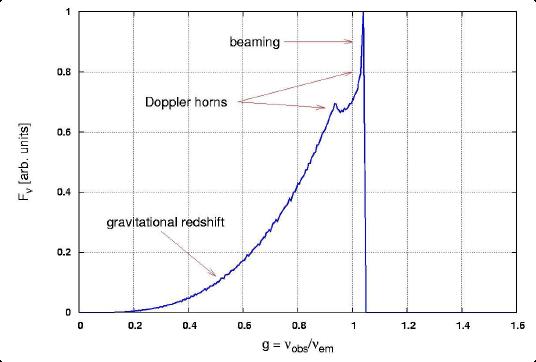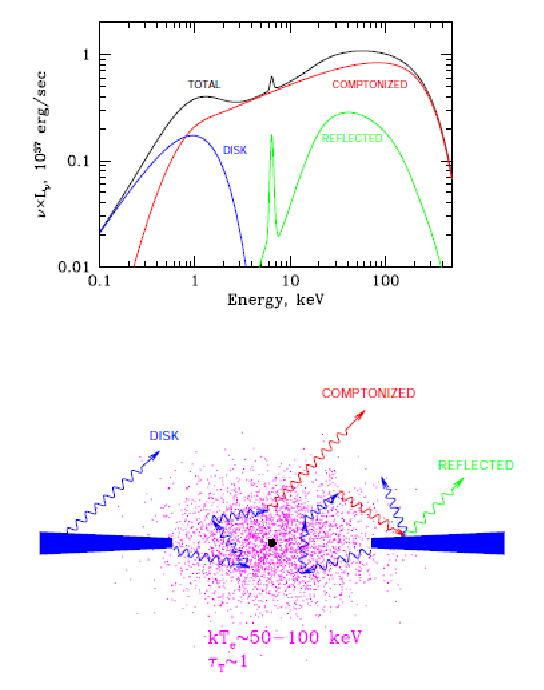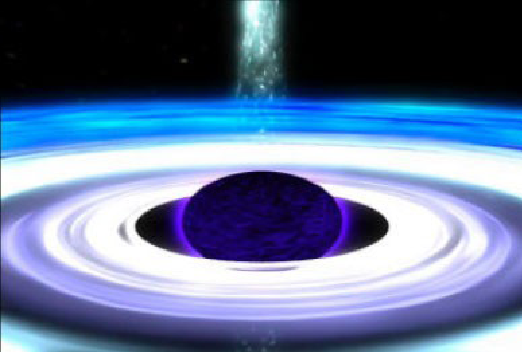| P4: Spectral Comparisons of Neutron Star Low Mass X-Ray Binaries to Black Hole X-Ray Binaries |
 |
 |
 |
|
Egron, Elise X-ray binary systems are composed by two stars which are gravitationally bound to each other: a compact object and a companion star. The compact object results from the final stages of the evolution of massive stars. According to the mass of the progenitor, a neutron star or a black hole is created. Also, two different types of binary systems are considered: Low Mass X Binaries (LMXBs) systems where the companion star has a small mass, and High Mass X Binaries (HMXBs) in the case of a massive star. In these systems, a mass transfer usually occurs; matter from the companion star is accreted onto the compact object, forming an accretion disc. Owing to the high temperature, emission of these systems is mostly in the X-ray range.  Figure 1 - Artist view of a LMXB system (http.//astro.virginia.edu) The study of the X-ray emission yields information about the physics of accretion and permits the determination of some properties of these systems, mainly concerning their geometry, the inner radius of the accretion disc, the inclination of the system with respect to the line of sight, the temperature of the disc, the temperature of the corona composed of relativistic electrons surrounding the compact object, and so on. About the compact object, these mysterious sources are very interesting since relativistic effects become important close to them because of their strong gravity. However, a direct observation (spatially resolved event) is inconceivable on account of its small size, even using the most powerful telescope. In the case of the black holes, as they are ''black'' objects they are not visible. Indeed, according to the general theory of relativity, a black hole is a region of space from which nothing, including the light, can escape. Therefore, they are undetectable in isolated systems. It is different in the case of a binary system; thanks to the interaction of the black hole with its companion, an indirect detection becomes potential. Up to now, a determination of the nature of the compact object is possible if the mass function is known (for masses upper than 3 solar masses, it is a black hole), or if bursts have been observed; in this case it is a neutron star. Sometimes, periodic electromagnetic pulses related to rotating neutron stars are detected. It should be very interesting to find some spectral characteristics allowing to clearly identify between black hole and neutron star. LMXBs containing an old and weakly magnetized neutron star should present spectra similar to the binary system with black hole candidates. Indeed, due to the low magnetized neutron star, accretion disc comes very close to the compact object, like in the case of black hole. That's the reason why analogies are observed in spectra of these systems.
Figure 2 - The dark gap between the accretion disc and the black hole represents the innermost stable orbit that matter can have before plummeting into the black hole. A spinning black hole allows matter to orbit closer to the black hole than it otherwise would. Credit Image: NASA.
Black holes candidates present very strong and relativistically smeared lines at 6-7 keV*, especially in the soft states. This state corresponds to a disc coming very close to the compact object because of a high accretion rate, contrary to the hard state where the disc is truncated far from the central object. Regarding LMXBs with a neutron star, a similar behavior is expected in the spectra. Indeed, broad iron lines at 6.47 keV are usually observed in these systems, and it has been suggested that these strong lines should be produced in the inner part of the accretion disc, due to the illumination of the disc by X-rays coming from the corona. There are identified with fluorescent Kα transitions of the iron at different ionization states.  As in the case of the black hole X-ray binaries, its profile should be distorted by different effects:
Taking into account these effects, the iron line profile appears broad an asymmetric.
Figure 3 - Example of relativistic emission iron line profile that is emitted from a thin accretion disc. Mueller, 2007, Proceedings of Science
Moreover, an absorption edge and a reflection bump should be visible in the spectra, produced as a consequence of the reflection of the main Comptonization continuum on an accretion disc. To explain these terms simply, a part of soft photons coming from the disc interact with hot electrons of high energy in the corona. These photons win energy, this process is called Inverse Compton. Then these photons can be reflected by the accretion disc, interacting with the cold matter of the disc.  Figure 4 - The three main components of the X-ray emission from an accreting black hole (top) and a plausible geometry of the accretion flow in the hard spectral state (bottom). (Marat Gilfanov,2009, arXiv:0909.2567)
These features represent a very powerful tool to investigate the structure of the accretion disc close to the central object. The purpose of this project is to perform a detailed and statistical study of reflection features in neutron star LMXBs, in order to demonstrate that these systems, in analogy with black holes, show relativistically smeared lines, although in these cases the relativistic distortions should never be as extreme as in systems containing black holes. This would give a further indirect but important evidence for the presence of an event horizon in black holes. To this aim, it is essential to use adequate self-consistent and complete reflection models including all the reflection features observed in spectra in order to fit correctly the broad band reflection features. This should allow to check the hypothesis that the iron discrete features are produced by reflection of the main Comptonized component by an accretion disc, and to investigate the presence of Doppler and relativistic distorsions. In addition to this, this study may highlight differences (if any) between the spectral properties of black holes and neutron stars, which may give important information on characterisics that are unique for each one of these compact objects. The work consists in a spectral analysis of data coming from different X-ray satellites: Chandra, XMM-Newton, Suzaku, INTEGRAL, Beppo-SAX, RXTE, Swift, which all have a broad band coverage and/or a good energy resolution at soft X-ray.
* keV: kilo electron volt is a unit of energy. It is 1 volt (1 joule divided by 1 coulomb) multiplied by the electron charge. One electron volt (eV) is equal to 1.602 176 5314×10−19 joules. |
